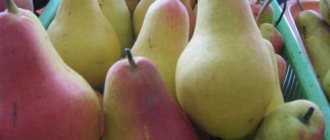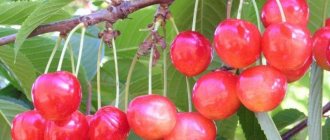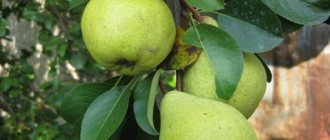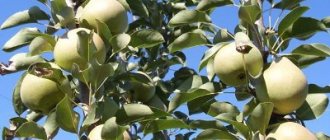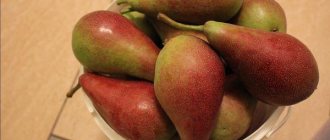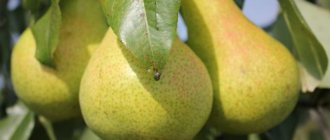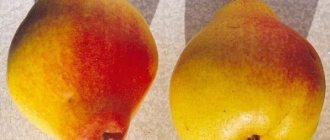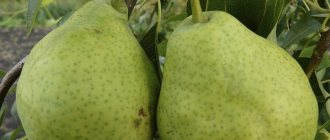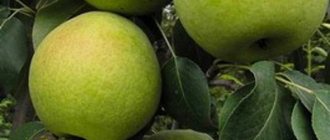Pear Bryansk beauty.
Description of the variety
The Bryansk beauty pear is one of the varieties of early autumn ripening. Thanks to its good hardiness, it is widespread in the gardens of the Central region and Central Russia.
Characteristics of wood
Trees of this variety have medium growth vigor. The height of an adult pear is 4-5 meters. The crown tends to thicken and has a pyramidal shape. The bark on the shoots has a dark burgundy tint. The leaves are dark green, medium-sized, and oblong in shape. The flowers are white, large.
Description of fruits
Pears are very large and weigh on average 250 grams. Some specimens can reach 450 grams. The fruits have a standard pear-shaped shape.
Bryansk beauty.
After ripening, the main color of pears becomes yellow. There is a beautiful burgundy blush on the surface. The taste of the fruit is sweet, with slight sourness and a pleasant aroma.
The harvest ripens in early September. The shelf life of picked pears in the refrigerator is about two months.
Characteristics of the Bryansk Beauty pear variety
Bryansk beauty is one of the few cultivars compatible with quince rootstock. The pear is characterized by good survival rate after grafting and planting the seedling in the ground. Selected variety with high immunity, stress-resistant. It withstands low temperatures well, but moisture deficiency can affect the growing season.
Drought resistance, frost resistance
After breeding, the variety was zoned under conditions of cold winters and relatively short summers. During experimental cultivation, the Bryansk beauty showed record results in frost resistance. Without additional insulation, the pear resists frosts down to -38 0C.
The fully formed root system of a pear is deepened within 60 cm; it cannot fully provide the tree with the moisture necessary for vegetation. Therefore, the Bryansk beauty consistently bears fruit only with sufficient water. Young seedlings have poor drought resistance and require periodic watering.
Pollinators
Bryansk beauty produces male and female flowers and cross-pollinates on its own, but other crop varieties located nearby will increase the yield. Fruit trees with the same fruiting period are suitable as pollinators for pears. The Bryansk beauty cultivar blooms in the second half of May, which means that pollinators with similar characteristics are selected for it. According to the reviews of experienced gardeners, Lada Amurskaya or Moskvichka pears planted nearby increase the yield of the Bryansk Beauty pear variety by up to 35%.
Productivity
The selection variety produces a harvest in 6-7 years of growth. After grafting or budding for the 3rd season, the first fruits are formed. For the Bryansk Beauty cultivar, the yield indicator is stable every year. The first fruits ripen at the end of August, the mass harvest takes place in mid-September. The level of fruiting is not affected by weather factors, the crop is stress-resistant, calmly reacts to temperature changes, and with timely watering it produces a good harvest.
Attention! A fruit tree produces an average of 18-20 kg of pears, with pollinators present up to 26 kg.
Application area
Bryansk beauty is classified as a dessert variety; the main use of the fruit is fresh consumption. The pear is stored for a long time; it does not lose its presentation and nutritional value for more than 15 days. The compact, medium-sized tree is cultivated in large areas of fruit and vegetable farms. Stable fruiting, transportability, and long shelf life make it possible to grow Bryansk beauty for commercial purposes. The fruits of the variety are universally used; they are processed into juice, jam, and jam. Wine is made at home.
Advantages and disadvantages
The pear has few disadvantages - it is average drought resistance and low yield without nearby pollinators. Basically, the culture is characterized positively; the advantages of the Bryansk beauty include:
- precociousness;
- stress resistance;
- high resistance to low temperatures;
- short stature, compact crown;
- stability of fruiting;
- high productivity;
- storage duration;
- transportability.
Reviews
Antonina
Yaroslavl
The variety is very good. In the first years, when the tree just began to bear fruit, there were few pears, but they were very large. Over time, the yield began to increase and the fruits became a little smaller. But, when compared with other varieties, they are still quite large.
Oleg
Cheboksary
When I bought the dacha, a pear tree was already growing on the plot. Overall the variety is good. The pears are very tasty, large and the harvest is always generous. But the main problem with the tree is scab. It is necessary to treat it several times a year, otherwise it immediately appears on both foliage and fruits.
Nikita
Snezhtsy
There are a lot of pears, this is a significant plus. It’s enough to leave them for the winter and roll them up in a jar. There are no complaints, the fruits are delicious, I am an unpretentious tree.
Features of cultivation
When choosing a site for planting pears, you should take into account the fertility of the soil, weather and climatic conditions characteristic of the area.
Landing location
Culture needs a lot of heat and light. In a shaded place, the shoots stretch out, productivity decreases, fruits will form only at the tops, since only light is available to them. The pear orchard should be illuminated by the sun most of the day.
The sunniest areas should be allocated for pear plantings.
It is preferable to plant fruit trees on small slopes with low groundwater (2.5 m). You should not plant pears in damp, low-lying places where moisture stagnates for a long time after snow melts and rains.
To avoid flooding, you need to make grooves to drain water or plant on mounds.
The crop grows and bears fruit well on fertile loamy or sandy loam soils with weak acidity. Acidic soil is alkalized with lime (500 g/m2), which is applied several weeks before planting. In clay areas, trees wither and bear little fruit. The structure of heavy soil will be improved by adding humus and sand (2 buckets/m2).
The pear should be protected from strong winds, especially in winter, when low temperatures are combined with low air humidity. Therefore, you need to plant a tree next to a fence or outbuildings.
In areas with fertile soil, receiving a lot of solar heat, the pear bears fruit well
Boarding time
Container seedlings are planted throughout the season using the transshipment method. The best time to plant bare-rooted pears in the Central region is early spring, before the buds open, when the air temperature is positive. In autumn, short periods of warmth are replaced by long cold spells, night frosts are not uncommon, and fragile plants planted in September may die. In the south, it is better to plant pears in the fall, no later than 2 weeks before the cold snap. By the end of November, with positive air temperatures and sufficient humidity, the plants will have time to take root.
Selection of seedlings
When choosing seedlings, you should consider them carefully. Usually, 1–2 year old plants with a developed root system, without signs of rot or damage, are purchased. There should be a seal on the stem 10 cm from the root collar - the grafting site.
Container seedlings are transferred along with a lump of earth; they are not injured during planting and have good survival rate
Seedlings purchased just before the cold weather are already too late to plant; they are buried. In the garden, they dig a trench with one inclined side, lay the plants on it and cover it with earth, covering it with spruce branches on top to protect them from freezing in the winter cold and damage by hares.
Correct fit
Planting pits 1 m x 75 cm are prepared in advance: for spring planting - in the fall, for autumn - 2 weeks before work. The fertile layer of soil is mixed with 2 buckets of humus, 100 g of superphosphate, 100 g of potassium salt (or 500 g of ash) are added.
Planting holes are prepared in advance so that the earth has time to settle
When planting fruit trees, instead of mineral mixtures, you can use vermicompost - an environmentally friendly, effective organic fertilizer. Granules (2 kg/m2) are mixed with the soil or the liquid concentrate is diluted in water (500 ml/10 l) and poured into the soil.
For better survival, the roots of the seedling are powdered with Kornevin or dipped in a solution with this stimulant for several hours.
Step by step process:
- Part of the prepared earth is poured into the hole in the form of a cone in the center.
- Lower the plant, spreading the roots in different directions. The seedling is transferred from the container into the hole along with a lump of earth.
The seedling is lowered into a hole with straightened roots
- A stake is driven in next to the tree.
- Sprinkle the seedling with soil, shaking it slightly so that there are no voids left. Compact the soil.
- Tie the plant to a peg to keep it from swaying in the wind.
The seedling is tied to a supporting support that does not allow strong winds to bend the young, fragile plant
- Water the tree by adding 20 liters of water into the watering grooves.
- Lay a layer of mulch from hay and straw.
- If planting is carried out in the spring, the trees are shortened to stimulate the regrowth of side shoots.
To protect seedlings from spring frosts, during the first days they are sprayed with Epin or covered with agrofibre.
Video: planting a pear seedling
Landing
Proper preparation of the planting hole and planting the seedling are a very important component of the successful strengthening and development of the pear. Detailed instructions and tips on the technology and features of planting the Bryansk Beauty variety can be found in the articles selected below.
How to plant a pear tree correctly
At what distance to plant pears?
How to choose pear seedlings
How to replant a pear
Why doesn't it bear fruit?
- Poor quality seedling. Buy planting material only from trusted suppliers.
- The tree is too young . This variety begins to bear fruit from 3 years after grafting.
- Lack of sunlight . Plant the pear tree in a well-lit place.
- Lack of nutrition . Fertilize the pear tree correctly and on time.
- Lack of moisture. The variety is moisture-loving; lack of moisture leads to few ovaries.
- Spring frosts. Frost can damage buds, flowers or ovaries.
- Feature of the variety . This variety does not bear abundant fruit.
Care
An adult tree does not need special care, but a young seedling should be given more attention in the first years after planting. Recommendations for growing and caring for the Bryansk beauty can be found by clicking on the links below.
How to care for a pear Pruning a pear Pruning a columnar pear Treating a pear from diseases and pests Feeding a pear How to water a pear
History of selection
The Bryansk Beauty pear variety got its name for a reason. She was bred near the city of Bryansk. Breeder N.I. Rozhnov discovered a new product, the merits of which were appreciated by many breeders. To this day, no one knows the history of the discovery of this variety.
It is believed that varieties such as “New Year” and “Williams Red” were used during selection. Initially, the variety was bred specifically for the Black Earth Region, but very quickly became popular in many other regions. The pear spread throughout the central part of Russia, including reaching the Urals.
Diseases and pests
Pear is not resistant to scab and many other diseases, so it requires regular preventive measures. Useful materials on how to protect the Bryansk beauty from pests and diseases can be found by clicking on the links below.
Dangerous Pear Pests
Pears often suffer from pests, they affect the leaves, bark and fruits.
In this article, we have selected 11 of the most harmful insects that harm pear trees, and also ways to destroy them.
Diseases of pear trees
To get what they cherish, gardeners have to work hard, and the reason for this is pear diseases.
Read about 19 common pear diseases and how to combat them.
Advantages and disadvantages of pear
Bryansk Beauty has both positive and negative properties.
Advantages of the variety:
- frost resistance;
- low susceptibility to diseases and pests;
- precociousness;
- high life expectancy;
- good taste and marketable quality of the crop;
- self-fertility.
The disadvantages include:
- high shedding and low fruit set;
- deterioration in crop quality during drought;
- instability to sharp fluctuations in temperature in winter;
- tendency to scab when exposed to excess moisture.
Characteristics of the tree and fruits
Bryansk beauty belongs to the early autumn varieties: the first fruits appear already in the 3rd year after grafting, and after another 3 years the tree produces a full harvest.
Quince is considered one of the most productive rootstocks suitable for pears. The tree is self-fertile, but cross-pollination with suitable varieties has a positive effect on the yield. The pear blooms quite late, which allows the inflorescences to avoid the harmful effects of spring frosts. A high degree of frost resistance can be noted, but temperature changes can have an extremely negative impact on the condition of the crop. Like all hybrids, Beauty is not prone to fungal infections and other diseases of fruit trees, but during prolonged periods of high humidity, scab may appear on the leaves. Pests and parasites are also not terrible for the pear.
The fruits are considered the main advantage of the variety. Their magnificent decorative appearance is not inferior to excellent taste characteristics. The light cream pulp with a delicate, slightly oily structure is very juicy, sweet and sour, literally melts in your mouth. The light aroma gives the taste a specific floral hue.
Dessert fruits are equally good for fresh consumption and for canning and jams. Pears ripen by early September. Can be stored in a cool place for several weeks, in the refrigerator - up to two months. Thanks to the hard skin, the fruits have good transportability.
It should be noted that the Bryansk pear needs good lighting and does not tolerate shade. The sun's rays promote the formation of sugars in fruits.
In addition, the tree needs sufficient space. The soil should be light, fertile, well ventilated with a neutral environment. Groundwater must lie at a depth of at least 2 m; excessive humidity contributes to root rotting. It is also necessary to choose the right watering regime: excessive moisture is harmful to the roots, drought affects the quality of the fruit.
Spring preventive treatment with copper-containing preparations will not harm. Formative and sanitary pruning is carried out seasonally. Trees are fed several times a year. In the spring, nitrogen-containing fertilizers, in the fall - mineral and organic. If there are significant temperature changes in the growing region, the pear is covered with burlap or pine branches during the cold season. The shelter will help protect the tree from rodents.
Water and loosen
Mulching retains moisture in the soil and prevents weeds from germinating. Photo: farmer.blog
- Provide the pear with good watering. Young trees especially need watering, since their root system is not yet sufficiently developed, and they cannot provide themselves with moisture from great depths. Water them at least once a week, using 20 liters of water per tree.
Mature trees are less dependent on watering, but lack of moisture also affects them negatively: they grow slowly in the spring, form the ovary worse in the summer, the quality of the fruit suffers, and tolerate cold worse in winter. Water them before and after flowering, spending up to 60 liters of water per pear. On the eve of the first frost, carry out water-charging irrigation at the rate of 80 liters of water per tree. Watering is carried out by sprinkling (except during the flowering period), drip irrigation or in grooves along the perimeter of the tree trunk circle.
- Loosen the soil after watering. This procedure makes it breathable, prevents the formation of a dense crust, which ensures good air flow to the roots. The depth of loosening should not exceed 8 cm so as not to damage the surface roots.
- Weed out weeds regularly. They take away nutrients from the pear and can become intermediate hosts for fungi and pests.
- Mulch the tree trunk circle after watering with humus or straw. Mulch preserves moisture, prevents the growth of weeds, creates a microclimate for the development of beneficial flora in the soil, and protects roots from heat in summer and hypothermia in winter.
- Start feeding the pear from 3 years after planting, if fertilizers were placed in the planting hole. Before the leaves bloom (during the swelling of the buds), feed the tree with nitrogen-containing fertilizers necessary for good growth (nitrate or urea). Instead, you can use organic fertilizers (manure or chicken droppings diluted in water). In the fall (September), feed the pear with phosphorus-potassium complexes. During the fruiting period, increase the intensity of fertilizing: after flowering, after shedding of the ovary and after harvesting to restore strength. Be sure to apply foliar fertilizing with magnesium sulfate. Its deficiency greatly reduces winter hardiness and leads to fruit shredding.
- Properly prune the Bryansk Beauty. For this variety it is best to form a sparsely tiered crown. The first pruning is done immediately after planting (in spring) and the shaping continues until 4 years. Mature trees undergo only regulatory pruning in the spring and sanitary pruning in the fall.
- Prepare the pear for winter. Mature trees do not need insulation. Young trees should be covered in the first years. After water-recharging irrigation, mulch the tree trunk circle and wrap the trunk with agrofibre or burlap.
- Prevent diseases.
Advantages and disadvantages
After such a detailed description, we should summarize some results, thanks to which we can clearly see why this pear is so loved, and what qualities it has that are not so shining.
We also relied on reviews from experienced and truly knowledgeable gardeners, which, by the way, were most often extremely positive.
Among the advantages of this variety, experienced gardeners highlight the following characteristics:
Productivity. It's really quite good, especially for a relatively small tree. With proper care, it is quite possible to harvest sixteen kilograms of pears from one square meter of plantings, which will also last until March. Flowers open at different times
For beginners, this plus will seem completely unobvious, but it is very important, especially when it comes to approaching frosts and snowstorms. On average, fruits begin to appear already in the third year after planting. However, if you are a beginner, this period may extend to four years, and therefore you should not be surprised at all. In addition to the fact that the plant is very well protected from winter frosts, it is also practically not afraid of droughts and survives very well during periods when there is little water. The variety is unpretentious, which, of course, is very important for those gardeners who are just starting their journey to growing large trees that require an eye and an eye for. As we have mentioned more than once, many note the extremely long storage of fruits, which benefits not only those who want to enjoy the fruits in the spring, but also those who sell pears
By the way, a huge advantage for them is both the size and marketable appearance, as well as the taste of the fruit, which only improves over time. The fruits are extremely easy to transport, load and unload, making them even easier to handle from a trading perspective.
Of course, there are obvious disadvantages of this variety, among which are the following:
- This variety, like almost any pear, is completely unstable to bacterial burns and infection by such an unpleasant disease as scab. These weaknesses are especially evident in damp summers.
- If the number of fruits increases significantly, their size and, to some extent, taste decrease. Therefore, the size of the crown must be constantly closely monitored.
- This plant requires the presence of pollinators, which, of course, adds trouble to the gardener. The best pollinators of the Belorusskaya late pear will be the following varieties: Conference or Bere Loshitskaya.
Otherwise, the Belorusskaya late winter pear variety is still extremely good, and we, without going back on our words, continue to recommend and praise it. Now that we have understood absolutely all the characteristics and features of this variety, and you are very familiar with it, we can proceed directly to the planting procedure.
